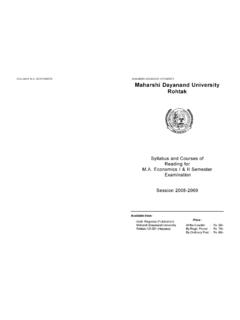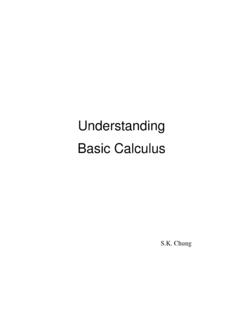Transcription of The Economics of Safety, Health, and Well-Being at Work ...
1 The Economics of safety , health , and Well-Being at Work: An OverviewPeter DormanInFocus Program on SafeWork, International Labour OrganisationThe Evergreen State CollegeMay, 2000 Note: The opinions expressed in this paper represent those of the author and not necessarily thoseof the ILO or its constituent Introduction: Why Economics ?Occupational injury and illness are matters of health , but they are also matters of Economics , sincethey stem from work, and work is an economic activity. The economic perspective onoccupational safety and health (OSH) encompasses both causes and consequences: the role ofeconomic factors in the etiology of workplace ill- health and the effects this has on the economicprospects for workers, enterprises, nations, and the world as a whole.
2 It is therefore a very broadperspective, but it is not complete, because neither the causation nor the human significance ofOSH can be reduced to its economic elements. The purpose of this paper will be to indicate themost important contributions economic analysis has made to our understanding and managementof OSH, and to suggest directions for future work in this means one thing to the specialist and another to the general public. When most peoplehear the word Economics , they think it has to do with the management of money. In particular, the Economics of occupational safety and health suggests for many little more than how canbetter working conditions be made profitable for business?
3 Certainly, the role of OSH, itsfinancial costs and benefits, in business management is an important aspect of economic analysis,but it does not exhaust the topic. Above all, Economics is a social science; its perspective is thatof society as a whole, which includes workers, their families and their communities as well asenterprises, and it recognizes that not all the effects of ill- health show up in monetary order to understand the contribution of Economics , then, it is important at the beginning to beclear on just what Economics has two general features that distinguish it from other social sciences. First, andobviously, it focuses primarily on the economy, the ways in which individuals and communitiesproduce, distribute and consume goods and services.
4 Modern Economics is most comfortablestudying market economies, since much more is known about the workings of markets than othertypes of economic mechanisms, but there are many economists who also study the Economics ofhouseholds, enterprise organization, and non-market societies of the past and present. In addition,economists generally assume that all decisions are made in a rational manner, where rationalityhas a very specific meaning. To be economically rational, a decision-maker is (a) outcome-oriented, basing his or her choices entirely on the predicted consequences of each action, and (b)systematically calculating, estimating the probability of each possible outcome and assigning eacha positive or negative value.
5 Because of this, the calculus of costs and benefits plays a central rolein economic reasoning. Of course, this is not an entirely accurate account of how decisions aremade in the real world, and in many situations calculations of costs and benefits play a minor , while conventional Economics does not provide a complete explanation of humanbehavior, its explanations will be more effective where market competition is an importantelement as it is increasingly coming to speaking, there are three general purposes that Economics can serve for OSH. First,identifying and measuring the economic costs of occupational injury and disease can motivate thepublic to take these problems more seriously.
6 This is true at all levels, from the enterprise thatmay be only dimly aware of the toll that worker ill- health takes on its performance to nationalgovernments that may not realize the impact of OSH problems on economic growth anddevelopment. Second, understanding the connections between the way firms and markets functionand types of OSH problems that arise is crucial for the success of public policy. Why areconditions better in some sectors or regions than others, and why are particular groups of workersat greater risk? What is the likely effect of changes in social insurance coverage, governmentregulation, or, for that matter, new international patterns of trade and investment?
7 As the pace of2economic change picks up throughout the world, these questions need to be addressed on acontinuing basis. Finally, as important as the protection of worker health and Well-Being is, it isnot the only objective of modern society. economic analysis can help show when safeguardingworking conditions is complementary to other social goals, and it can illuminate the tradeoffs whenit is not. Clearly, to the extent that there are tradeoffs, they don t go away if we refuse to all of these goals, a central concept is that of costs. On the one side, we have the costs ofimproving the conditions of work, in order to reduce the incidence of injury and disease.
8 On theother, we have the costs of not doing these things. But the concept of costs is not simple; there aremany kinds of costs, and the distinctions are important for the analysis of OSH. I will have moreto say about this in later sections; for now, these will be the ways we will distinguish costs: economic vs noneconomic costs. Without going deeply into the subtleties of economic theory, itis enough to say that economic costs are those which can be expressed in monetary units. Theyinclude the costs paid or expected to be paid by individuals and organizations acting within theeconomy, as well as the monetary values implicit in activities undertaken and costs are no less real, but for one reason or another cannot be captured in monetaryterms.
9 In the case of injury and disease, the noneconomic costs are above all the subjective costsof pain, fear, and loss suffered by the victims, their families, and their immediate shorthand, we will refer to them as the human costs of ill- health or premature death. Inaddition, it should be recognized that the loss of life and health is often opposed for reasons thatare not reducible to their cost in either the economic or noneconomic sense. This is particularlythe case when standards of social justice are violated: what may make a particular injuryunacceptable, for instance, may not be (only) its cost, but also the fact that it could have beenprevented but wasn t, due to the employer s obsession with making the greatest possible vs social cost.
10 All the costs of worker ill- health , to whomever they might accrue, couldbe added up; this sum would be the full social cost. Society has traditionally been thought ofas equivalent to the nation, but it makes increasing sense to think of the entire world as our society,due to economic integration. Within this overall accounting, however, costs fall on differentparties. The particular portion of the cost paid by any one individual or organization is called theprivate cost, and this is the cost relevant for decision-making on that level insofar as the decision-maker is economically rational. Three points should be borne in mind. First, private costs do notnecessarily enter into the social cost, because they may be offset by benefits to other members ofsociety.
















